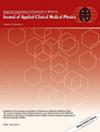Integrating surface-guided radiation therapy and continuous positive airway pressure for breast cancer: Improving reproducibility and efficacy
Abstract
Background
The utility of surface-guided radiation therapy (SGRT) with continuous positive airway pressure (CPAP) remains underexplored compared to its application with deep inspiratory breath hold (DIBH). This study investigates the integration of CPAP and SGRT, focusing on positional reproducibility and treatment efficiency.
Purpose
This study evaluated the impact of patient surface displacement during breast cancer radiation therapy using optical and thermal SGRT monitoring and compared treatment time characteristics between patients undergoing SGRT, either with or without CPAP, and a cohort of patients undergoing treatment without SGRT.
Methods
The SGRT cohort comprised thirty patients: 15 with CPAP (CPAP + SGRT) and 15 without CPAP (SGRT-only). The surface displacement was monitored using an advanced optical and thermal SGRT system with thresholds of 3 mm for translational and 2.5° for rotational displacement. Treatment workflow metrics and positional deviations were assessed across 16 fractions. A comparative analysis included a cohort of 27 free-breathing (FB) patients who did not receive SGRT.
Results
Positional reproducibility was similar in both SGRT groups, with translation vectors of 1.46 ± 0.98 mm (CPAP + SGRT) and 1.37 ± 0.80 mm (SGRT-only) and rotation vectors of 0.57 ± 0.40° and 0.57 ± 0.39°, respectively. Despite comparable displacement control, treatment delivery time variability was highest in the CPAP + SGRT group (normalized standard deviation: 0.16), followed by the SGRT-only (0.11) and FB groups (0.03). The broader time distributions in the SGRT group were attributed to beam-hold activations exceeding the displacement thresholds, whereas total treatment time did not differ significantly between groups.
Conclusions
SGRT effectively minimized displacement-related uncertainties during breast cancer radiation therapy with and without CPAP. Although CPAP provides additional internal stabilization and its integration with SGRT increased treatment delivery time variability, the total treatment time remained comparable across all groups. These findings underscore the potential of SGRT and CPAP as complementary tools to enhance precision and safety, particularly for techniques requiring high positional accuracy.


 求助内容:
求助内容: 应助结果提醒方式:
应助结果提醒方式:


